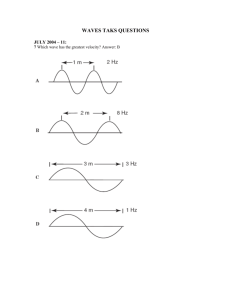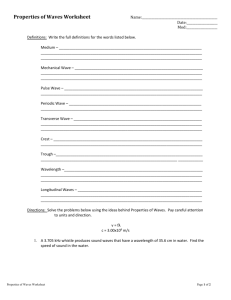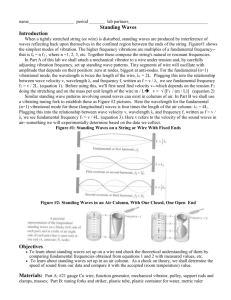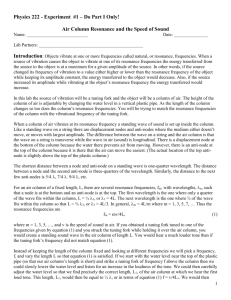Video # 1: Demonstration of resonance Video # 2: Resonance on a
advertisement
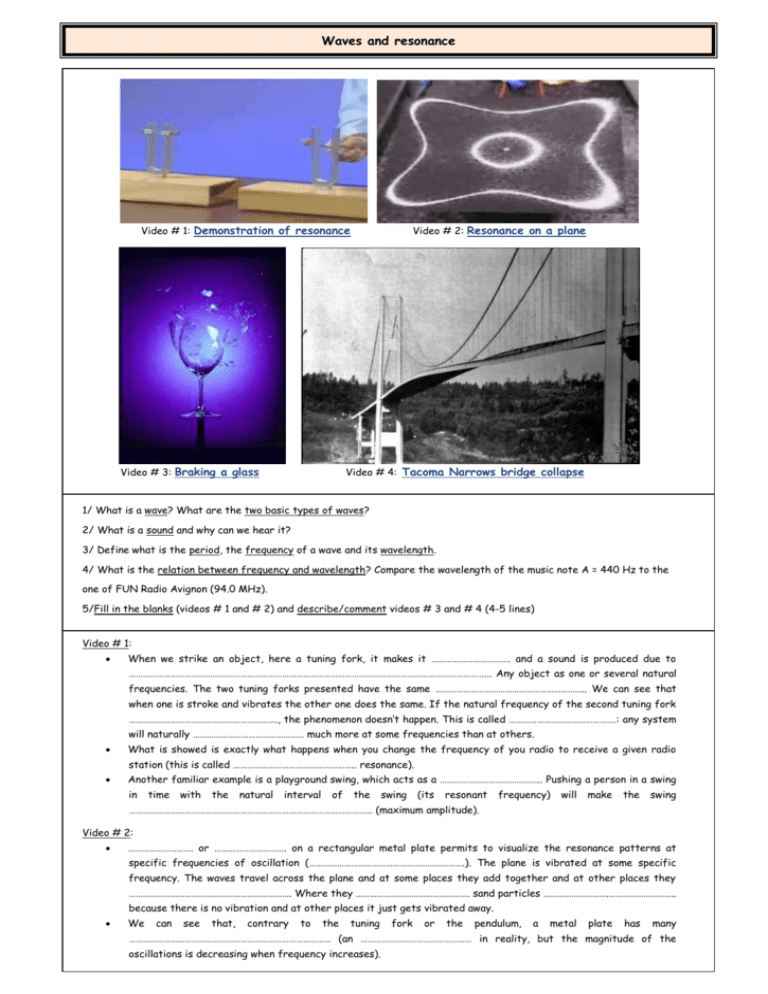
Waves and resonance Video # 1: Demonstration of resonance Video # 3: Braking a glass Video # 2: Resonance on a plane Video # 4: Tacoma Narrows bridge collapse 1/ What is a wave? What are the two basic types of waves? 2/ What is a sound and why can we hear it? 3/ Define what is the period, the frequency of a wave and its wavelength. 4/ What is the relation between frequency and wavelength? Compare the wavelength of the music note A = 440 Hz to the one of FUN Radio Avignon (94.0 MHz). 5/Fill in the blanks (videos # 1 and # 2) and describe/comment videos # 3 and # 4 (4-5 lines) Video # 1: When we strike an object, here a tuning fork, it makes it ……………………………. and a sound is produced due to ………………………………………………………………………………………………………………………………………... Any object as one or several natural frequencies. The two tuning forks presented have the same ……………………………………………………….. We can see that when one is stroke and vibrates the other one does the same. If the natural frequency of the second tuning fork ………………………………………………………., the phenomenon doesn’t happen. This is called ……………………………………….: any system will naturally ………………………………………… much more at some frequencies than at others. What is showed is exactly what happens when you change the frequency of you radio to receive a given radio Another familiar example is a playground swing, which acts as a …………………………………….. Pushing a person in a swing station (this is called …………………………………………….. resonance). in time with the natural interval of the swing (its resonant frequency) will make the swing …………………………………………………………………………………………… (maximum amplitude). Video # 2: ………………………. or …………………………. on a rectangular metal plate permits to visualize the resonance patterns at specific frequencies of oscillation (………………………………………………………….). The plane is vibrated at some specific frequency. The waves travel across the plane and at some places they add together and at other places they ……………………………………………………………. Where they …………………………………………. sand particles ……………………….……………………….. because there is no vibration and at other places it just gets vibrated away. We can see that, contrary to the tuning fork or the pendulum, a metal plate has many …………………………………………………………………………… (an ………………………………………… in reality, but the magnitude of the oscillations is decreasing when frequency increases). 1/ What is a wave? What are the two basic types of waves? A wave is a disturbance that travels through space and time. There are two basic types of wave motion for mechanical waves: longitudinal waves and transverse waves. For longitudinal wave the displacement is parallel to the direction of wave propagation and for a transverse it is perpendicular. 2/ What is a sound and why can we hear it? We hear sound when a moving object makes the air vibrate. These vibrations travel through the air in the form of waves and are picked up by our ears as sounds. The sound is a longitudinal mechanical wave. 3/ Define what is the period, the frequency of a wave and its wavelength. Frequency F (or sometimes: ν) is the number of occurrences of a repeating event per unit time. The SI unit of frequency is Hertz (Hz). The period, usually denoted by T, is the duration of one cycle in a repeating event. The SI unit of period is second (s). The relation between frequency and period is: F = 1/T The wavelength λ is the spatial period of a wave (the distance over which the wave's shape repeats). It is measured in meters (m). Time 4/ What is the relation between frequency and wavelength? Compare the wavelength of the music note A = 440 Hz to the one of FUN Radio Avignon (94.0 MHz). The relation between frequency and wavelength is: λ = c/ν where c is the speed of the wave in the medium. For the music note: c = 340 m/s and λ = 340/440 = 0.773m or 77.3 cm For the radio station: c = 3.00x108 m/s and λ = (3.00x108) / (94.0x106) = 3.19m We can see that both waves have the same order of magnitude. 5/Describe and comment the four videos (4-5 lines / video) Video # 1: When we strike an object, here a tuning fork, it makes it vibrate and a sound is produced due to the oscillations of the molecules of the air. Any object as one or several natural frequencies. The two tuning forks presented have the same natural frequency. We can see that when one is stroke and vibrates the other one does the same. If the natural frequency of the second tuning fork is changed, the phenomenon doesn’t happen. This is called resonance: any system will naturally oscillate much more at some frequencies than at others. What is showed is exactly what happens when you change the frequency of you radio to receive a given radio station (this is called electrical resonance). Another familiar example is a playground swing, which acts as a pendulum. Pushing a person in a swing in time with the natural interval of the swing (its resonant frequency) will make the swing go higher and higher (maximum amplitude). Video # 2: Sand or salt on a rectangular metal plate permits to visualize the resonance patterns at specific frequencies of oscillation (natural frequencies). The plane is vibrated at some specific frequency. The waves travel across the plane and at some places they add together and at other places they cancel out. Where they cancel out sand particles don’t move because there is no vibration and at other places it just gets vibrated away. We can see that, contrary to the tuning fork or the pendulum, a metal plate has many natural frequencies (an infinity in reality, but the magnitude of the oscillations is decreasing when frequency increases). Video # 3: In this video, we can see that glasses give off sound when we rub them with a wet finger. The frequency we can hear depends on the level of water (as well as the natural frequency of a mechanical system depends on its shape). If we generate a sound with a speaker, it will make the glass vibrate. When a natural frequency is reached, the glass is broken due to the resonance. If the frequency of the voice is higher the wavelength is lower because λ = c / ν… Video # 4: Tacoma Narrows Bridge was constructed near Washington in 1940. It was the longest suspended Bridge and it opened up in July 1, 1940. Four months later, strong winds (42 mph) caused the bridge to collapse. This is an example of what can occur if a resonance phenomenon happens.



